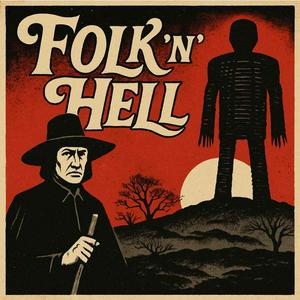Tumbbad
This time on FolknHell, Andy, David, and Dave take their first cinematic trip to India for the visually lush, rain-drenched folk horror tale Tumbbad — a film dripping with myth, greed, and muddy moral compromise. Set across three distinct time periods (starting in 1918), Tumbbad charts the generational consequences of disturbing a slumbering god called Hastar — a deity born from the womb of the Earth itself, cursed for his insatiable hunger for gold and grain.From the outset, the trio are intrigued by the film’s opening premise: two boys, their fearful mother, and a mummified, flesh-eating grandmother chained in a rain-lashed house. She's more than just scenery-chewing horror — she's a symbolic custodian of a secret too powerful to ignore. As one of the boys (Vinyak) grows up, he inherits more than just the legend — he learns how to exploit it.The podcast digs into how Tumbbad unfolds as a cursed treasure tale in three acts. Each chapter marks a shift: discovery, exploitation, and eventual inheritance. It’s a slow-burn saga of ambition and consequence, with each generation slipping further into moral decay. And yet, it’s the film’s atmosphere — perpetually soaked in rain and shadow — that captivates the team. As David Hall notes, “it’s like the locks and buildings go back 5,000 years,” a touch that lends the film a tangible, earthy mythology. Dave Houghton likens the treasure chamber to a Lovecraftian womb — grotesque, alive, and utterly compelling.A key discussion point centres on the folklore itself. Is Hastar a ‘real’ myth from Indian tradition, or a modern invention? The team suspects the latter — but agree that its invented lore still speaks to deep-rooted, folkish fears: cursed wealth, intergenerational sin, and the risks of unearthing that which should stay buried.Stylistically, Tumbbad impresses across the board. The trio praise the production design, use of colour (especially in the womb scenes), and practical effects. While Andy finds the first act a bit slow and overly long, all three hosts are in agreement that the film delivers richly on mood, world-building, and originality.Is it folk horror? By the podcast’s own criteria — a threat localised to a community, of the environment, and from another time — the answer is a resounding yes. Hastar lives in the earth, only emerges when summoned with ritual dolls, and the curse is bound to the landscape of Tumbbad itself. As Dave notes, even if the deity isn’t ancient in mythological record, the film still channels the right vibes: a god of limitations, rooted in soil and secrecy.The final score? A consensus 21/30 — solid sevens across the board. It’s a “low B” in their unofficial ranking system, but a high recommendation. The team wish more people could see Tumbbad easily, noting that the version they watched used fan-made subtitles, a hint at its frustrating lack of UK distribution.Expect spoilers, references to The Mummy, Kenneth Williams, Monkey magic, and spirited discussion about whether multiple dolls create multiple gods (spoiler: they don’t). As always, the boys close with warmth, irreverence, and a hint that this mysterious Indian horror might just be one of their most memorable discoveries yet.Enjoyed this episode? Follow FolknHell for fresh folk-horror deep dives. Leave us a rating, share your favourite nightmare, and join the cult on Instagram @FolknHell.Full transcripts, show notes folkandhell.com. Hosted on Acast. See acast.com/privacy for more information.


